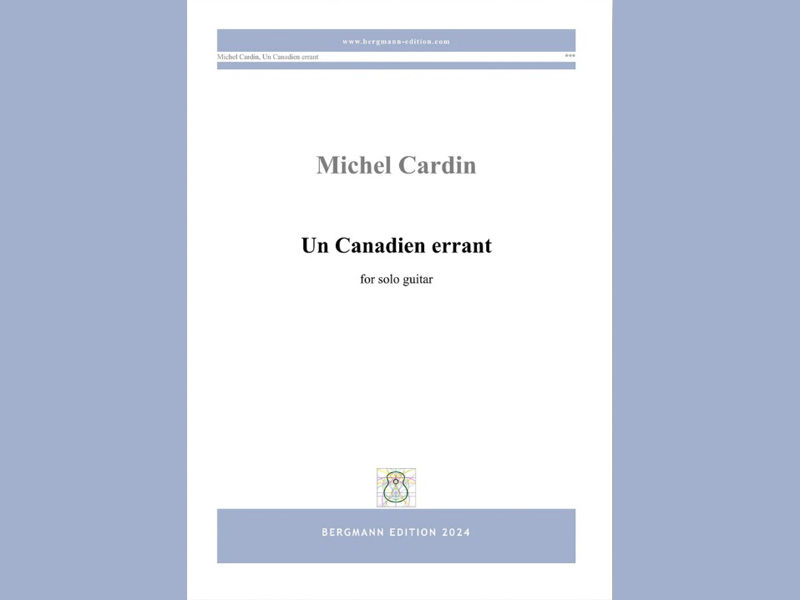Michael Knopf : Once Around the Sun Volume 1 : Bergmann Edition
- chrisdumigan
- Oct 7, 2022
- 3 min read

Michael Knopf
Bergmann: 34 pages
Michael Knopf is an American born player now residing in Australia, for many years. This volume is apparently only the first of many volumes because the aim of the title Once Around the Sun was to produce 365 new works, which he commenced doing in 2016, evidently trying to produce one new piece every day. Unsurprisingly he didn’t quite make that, but nevertheless managed to have written 280 pieces by mid-2020.The idea was to write mostly concert style works that also work as studies in various techniques as well as being very varied in musical content and technical requirements.
This first book in the series is fifteen pieces in all, and are in my estimation certainly too hard for anyone less than a player with a moderate technique to even consider trying. In his Preface he lists a multiple number of musical styles that have influenced these pieces
As they stand they are very modern in harmony and although the pieces themselves are quite varied in speeds and keys and other musical things, they all have that ‘bite ‘ to them with regards to the harmonic language, which, to be fair won’t suit every player, clever and imaginative though they are.
So for example, the No1 piece is sub – titles At The Tomb of the Maestro, with a Dm key signature and a dropped D 6th and a Grave instruction. Having started off suitably serious, but not too harmonically unusual, one suddenly finds the part writing turning very modern and, as a result, very tricky to read and play. Add to that the chords that are very modern in sound, (and therefore not immediately easy to read) , like, for example one consisting of Ab, D, G, C, and top G, or another Ab, G, D, E natural and top C, ( both in 5th position)and you may realise just how unusual some of this material is. However as it was a piece about death, I assumed that others might be quite different.
Piece No2 Cliff and Moon however begins with a dissonant chord of low E, D#, G, A#, E, and top F# before, after a fast solo note run over the fingerboard, becoming a reiterated chord of C, D, Bb, and Eb, with changing bass notes underneath , before landing on a chord of E, Bb, F#, A, D, and F natural. The fast runs then continue, alternating with these imaginatively dissonant chords.
After a piece called Tremolo, (which is precisely what it is) No4 is an Andante Pesante whose introduction is violent chords of an unusual quality turning into a Piu Mosso, and then via a molto accelerando into a semi – quaver Moderato repeating idea that eventually dies away via some different but still quite unusual chords interwoven with repetitive single note ideas.
No5 (Idyll) is to be tuned with a 3rd to F#, and a 6th to D, and is full of mostly two voices often in very small note values covering a great deal of the fingerboard as they travel along their way.
No6 with a 6th to F, is marked Energetically and is full of double note pull offs in all manner of places atop a repeating low F, which after a few bars gets significantly harder as the piece progresses.
No7 is a similar study style of piece only here the repeating pattern is a sextuplet semi – quaver idea consisting of multiple pull – offs to open strings with various long notes underneath. Incidentally there are one or two that I couldn’t work out the fingering for, such as bar 4 , with a top space E that is supposed to be a semi – breve, whilst the top part pulls off a seventh fret B to an open E. Fair enough , you might say, the long E must be string 2.No, for the next note in the sextuplet is an open B 2nd string. So, you say, the long E must be string 3 then? Well, how in that case are you supposed to finger the first 7th fret B with finger 4 of your left hand? There were more places similar to that problem here.
I could go on and discuss all fifteen pieces in this book, but I think you might get the idea of how they feel from my words up above.
They are exceedingly tricky, so only very good players need look at them, but also they are unrelenting in their modernity, which delights lots of people, and appalls others, for you definitely will not sit on the fence with this set.
Chris Dumigan




Comments